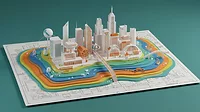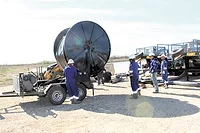Water System Infrastructure Issues

The need includes installation of new infrastructure as well as rehabilitation or replacement of deteriorated or undersized infrastructure. It also includes the need to address aging infrastructure that is adequate now but will require replacement or significant rehabilitation over the next 20 years. Most of the needs are not related to violations of any Safe Drinking Water Act (SDWA) regulations. Instead, they are ongoing investments that systems need to make to continue to deliver water to their customers, as well as to remain in compliance with regulations.
The nation's 1,041 largest community water systems (those serving populations more than 50,000 people) account for $122.9 billion, or 44 percent of the total national need. Medium and small community water systems also have substantial needs of $103.0 billion and $34.2 billion, respectively.
Current and Future Needs
The latest Needs Assessment differentiates current needs from future needs. About 60 percent of the total needs, $165.0 billion, are identified as current needs. Although current needs have increased in dollars from previous assessments, they are a smaller percentage of the total need in 2003 (60%, compared with 68% in 1999). Current needs are projects that a system considers a high priority for near-term implementation to enable a water system to continue to deliver safe drinking water. For instance, a system may have had numerous leaks and breaks in a section of main that should be replaced before a major main break occurs and inhibits the delivery of safe drinking water. A system with current needs is not necessarily in violation of any health-based drinking water standard or in the midst of responding to an emergency. For example, a surface water treatment plant may currently produce safe drinking water, but the plant's filters may require replacement because of their declining effectiveness. By replacing the filters, the plant would be able to continue providing safe water and avoid emergency situations.
Future needs are projects that water systems do not currently need, but would expect to address in the next 20 years as part of routine rehabilitation or replacement of infrastructure because of predictable events, e.g., reaching the end of a facility's service-life. Approximately 40 percent of the total need, $111.8 billion, is reported as future needs.
Different Project Types
Every project in the latest Needs Assessment belongs to one of five categories of need - transmission and distribution, treatment, source, storage or “other.”
- Transmission and Distribution. With $183.6 billion needed over the next 20 years, transmission and distribution projects constitute the largest category of need, accounting for almost two-thirds of the total need. Little of this category of need is related to any federal mandate. Instead, utilities need to install and maintain distribution systems to provide potable water to their customers while preventing contamination of that water prior to delivery. Although treatment plants or elevated storage tanks usually are the most visible components of a water system, most of a system's infrastructure is underground in the form of transmission and distribution mains. Failure of transmission and distribution mains can interrupt the delivery of water leading to a loss of pressure, possibly allowing a backflow of contaminated water into the system. Broken transmission lines also can disrupt the treatment process. The transmission and distribution category also comprised the largest proportion of the total need in the 1995 and 1999 Needs Assessments. The transmission and distribution category includes the installation and rehabilitation of raw and finished water transmission mains and distribution mains and replacement of lead service lines, flushing hydrants, valves, meters and backflow prevention devices.
- Treatment. Treatment projects represent the second largest category of need, $53.2 billion, nearly one-fifth of total need, over the next 20 years. This category consists of projects needed to reduce contaminants through treatment processes such as filtration, disinfection, corrosion control and aeration. The installation, upgrade or rehabilitation of treatment infrastructure also enables removal of contaminants that can cause chronic health effects or taste, odor and other aesthetic problems.
- Storage. The total 20-year need for storage projects is $24.8 billion. This category includes projects to construct new or rehabilitate existing finished water storage tanks. Construction of new tanks is necessary if the system cannot provide adequate flows and pressure during peak demand periods. Many projects in this category involve rehabilitating existing tanks to prevent structural failures or sanitary defects that can allow microbiological contamination.
- Source. The source category includes projects that are necessary to obtain safe supplies of surface water or ground water. The infrastructure needs in this category include the installation and rehabilitation of drilled wells and surface water intakes. The total 20-year needs for source water projects are $12.8 billion.
- Other. Other needs account for an estimated $2.3 billion. This category captures needs that cannot be assigned to one of the prior categories. Examples include emergency power generators not associated with a specific system component, computer and automation equipment, and projects for system security.
Regulatory Requirements
The SDWA requires that public water systems meet national standards to protect consumers from the harmful effects of contaminated drinking water. Although all of the infrastructure projects included in the 2003 Needs Assessment promote the SDWA's public health objectives, most are driven by the need to provide an essential service to the utility's customers. However, some of the projects are directly attributable to specific SDWA regulations. The total regulatory need is divided into two broad categories - the need associated with existing SDWA regulations, and the need associated with recently promulgated and proposed regulations. The second category accounts for new or proposed regulations that may impact systems in the near future, even though systems have not yet determined the extent to which they will need capital investment to achieve compliance.While most of the total need is not driven by compliance with a particular regulation, properly maintaining a system's infrastructure not only is economical in the long run, but also is protective of public health. These non-regulatory costs include routine installation, upgrade and replacement of basic infrastructure, and are borne by the system regardless of regulations.
The estimated needs directly associated with existing SDWA regulations (including the recently promulgated Arsenic Rule that will be effective in January 2006) are $35.2 billion.
Projects that address microbiological contamination comprise 86 percent, or $30.2 billion, of the total existing regulatory need. Under the SDWA, the Surface Water Treatment Rule, the Interim Enhanced Surface Water Treatment Rule, and the Total Coliform Rule are designed to remove or inactivate microbial contaminants in drinking water. Microbial contaminants, such as Giardia and E. coli, can cause acute gastrointestinal illness and, in extreme cases, death. The installation of a treatment plant to filter a surface water source or the replacement of an aging disinfection system are examples of needs in this category.
Projects designed to protect the public health from chemical contaminants comprise $5 billion, or 14 percent of the total existing regulatory need. This category includes projects necessary for compliance with the existing Nitrate/Nitrite Standard, the Lead and Copper Rule, the Total Trihalomethanes Standard and the recently promulgated Arsenic Rule, as well as other regulations that set maximum allowable limits for organic and inorganic contaminants. Examples of projects in this category include aeration facilities to remove volatile organic compounds or projects to add corrosion control to reduce the leaching of lead from pipes.
The total need associated with proposed and recently promulgated regulations is $9.9 billion. Of this total, $3.2 billion is for the regulation of acute contaminants under the Long Term I and/or the Proposed Long Term 2 Enhanced Surface Water Treatment Rules, the Proposed Ground Water Rule and the Filter Backwash Recycling Rule. The remaining $6.7 billion is for chronic contaminants regulated under the Stage 1 and/or the Proposed Stage 2 Disinfectants/ Disinfection Byproducts Rule, the proposed Radon Rule and the recently promulgated Radionuclides Rule.
Security Concerns
Water systems have long included protections against vandalism and natural disasters as part of their water system improvement programs. However, systems have only recently begun to address more robust security needs to identify and protect the system from terrorist-type activities. These were not the types of costs that EPA was prepared to model. It is anticipated that these needs will be more completely reported in future assessments. The total security need estimated from the 2003 Needs Assessment is $1 billion.Challenges for the Future
All assessments that include surveys impose a data collection burden on respondents. EPA has considered options to reduce respondent burden in each of the most recent assessments. These efforts must be renewed in planning for the next assessment. EPA will pay particular attention to the number of projects to be considered in a 20-year planning effort, the comprehensiveness of the data collection goal, and documentation requirements for each project. All of these factors create a burden for participating water systems, state agencies and EPA. While the data obtained through the survey and assessments are extremely valuable for many applications, the approach used to collect the data is regularly reviewed by EPA to determine more efficient and effective ways to capture the full need.EPA is addressing two additional issues for future assessments - engineering assumptions of life cycles for future rehabilitation and replacement projects, and encouraging greater response rates from systems in states receiving capitalization grants.
With respect to life cycle assumptions, more explicit nationally applicable guidelines would facilitate consistency from the outset of the assessment. This would streamline quality control efforts and eliminate the need to identify assumptions used in projections of infrastructure replacement and rehabilitation needs (and reject projects where assumptions are inconsistent with industry practice). Regarding response rates, states that are near or below 1 percent of the total national need have little incentive to promote responses from systems in their jurisdictions. This can lead to underestimates of the needs in these states.
In the estimation of total national needs, these two issues may partially offset each other. Inconsistent engineering assumptions may drive needs up, but low response rates in states receiving minimum capitalization grants may drive needs down. EPA recognizes that assessment methods result in uncertainty in the estimated needs. The sampling plan for medium and large systems was designed to produce estimates of the total need for each state with 95 percent confidence intervals that are ± 10 percent. However, sampling error is only one source of uncertainty. The assessment also involves statistical cost models and economic analyses of regulations. Each of these creates additional uncertainty. While the 2003 Needs Assessment does not include a comprehensive quantitative analysis of uncertainty, EPA plans to continue efforts to mor e accurately characterize these in future assessments.
The need to rehabilitate and replace infrastructure is expected to increase as systems age, particularly if funding constraints limit the systems' ability to meet these needs. The needs summarized in this report highlight the challenges facing water systems as they cope with aging infrastructure in the 21st century.
ND
Looking for a reprint of this article?
From high-res PDFs to custom plaques, order your copy today!




